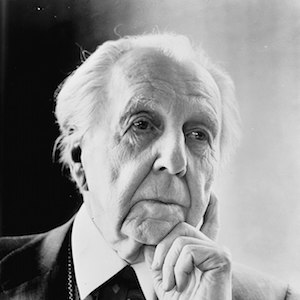Frank Lloyd Wright
Mid-Century Modern Architect
Wright’s hefty design resume includes over 1,000 structures but scarcely half (532) were actually built. Here are some of the more unusual things that Wright designed:
1 – An eco-friendly roof. Before proponents of the sustainable design movement were even born Wright created a “green” roof for his son’s house.
2 – The Imperial Hotel in Tokyo, Japan. American architects had always drawn inspiration from European and Asian influences but in 1913 Wright became one of the first Americans to be recruited for overseas projects. He became an ardent collector of Japanese woodblock prints, a passion that often contributed more to his bank account than his architectural work.
3 – Dresses. Wright was said to occasionally dabble in fashion design for clients and family members.
4 – Automobiles. Wright was arriving at job sites in a horse and buggy before the automobile was even invented. He became an early enthusiast, owning more than 50 cars in his life. None was more beloved than his yellow convertible Stoddard Dayton that he built from scratch.
5 – A house for Marilyn Monroe. Wright was born in 1867, only two years after the Civil War ended and yet his career was so long he was still designing houses for celebrities in the 1950s.
6 – A college campus. In Lakeland, Florida Wright designed 13 buildings to launch Florida Southern College, many using textured blocks. He also added to campus a Usonian House, his modernist take on affordable housing. Florida Southern represents the largest single-site collection of Wright architecture in the world and is always on any list of America’s most beautiful campuses.
7 – Lincoln Logs. OK, Frank Lloyd Wright did not invent the iconic children’s toy but his son Jon borrowed his father’s construction techniques to create the interlocking building kits.
Wright’s genius did not arrive in the Delaware Valley until the architect was well into his seventies. Most of his commissions were private residences – a house in the north Wilmington suburbs, the Usonian J.A. Sweeton house in Cherry Hill, a collection of four Usonian houses in Ardmore known as the Suntop Homes.
In 1953 Wright received a letter from Rabbi Mortimer Cohen, whose Beth Sholom congregation was moving from its home of 35 years in North Philadelphia to the suburbs in Elkins Park. Cohen explained that he was looking for the congregation’s new home to be a celebration of the American experience for the European Jewish community and what better architect to express that essence than Frank Lloyd Wright. Wright bought the pitch and agreed to design his first, and only, synagogue.
Whereas the integration of architecture with the natural environment permeates much of Wright’s work, in Elkins Park he created Beth Sholom as a modernist Mayan temple, a glass-sheathed pyramid visible for miles in every direction. Construction was not completed until 1959, just months after Frank Lloyd Wright died at the age of 91. Today the National Historic Landmark is open to the public and can be toured when no synagogue functions are taking place.

